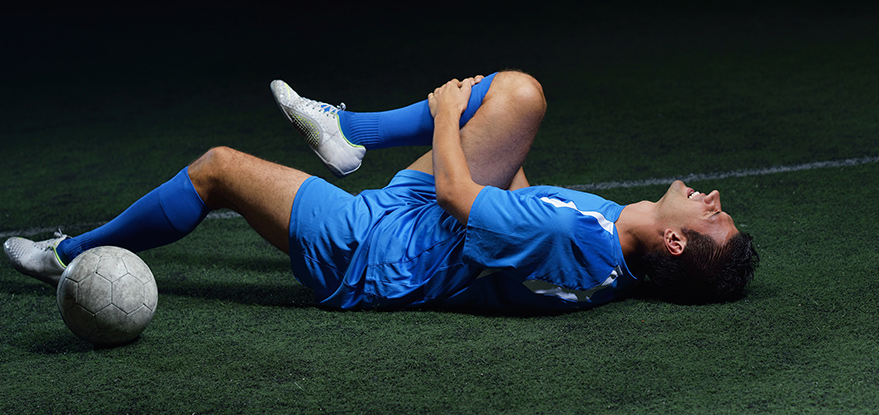During my teenage years in the Ukraine my older brother who was 20 at the time and was crazy about bodybuilding which was new where we were from. We both learned English to be able to read “Muscle and Fitness” magazine to learn how muscles function. Bodybuilding equipment didn’t exist at that time which led my brother to open the first bodybuilding gym in our home town of Odessa, Ukraine. Although muscle function was extremely interesting to me, my passion was playing soccer. At the time I was playing in the youth academy of a professional soccer team. Due to my competitive nature I suffered an injury that I thought was a sprain. It turned out that I had what is known as severe ankle injury, which the doctors called, “habitual ankle subluxation.” The x-rays didn’t reveal any fractures and because there were no MRI machines at the time the diagnosis of “habitual ankle subluxation” we now know what I actually suffered with is “chronic ankle instability” known as “CAI.”
CAI is a condition in which torn or sprained ligament of the ankle lose their ability to stabilize the ankle joint during walking and running. With the appearance of the MRI we now know that most of these CAI’s are connected to osteochondral damage to the joint. However, back when I was 17 none of that technology was available and there was no knowledge of how to diagnose and treat these conditions. Ankle sprains are not an uncommon occurrence, but only a small percentage of these patients (known as: non-copers) go on to develop chronic ankle instability.
Unfortunately, I was one of the unlucky one’s and my ankle became more and more unstable to the point I was no longer able to play mid field and had to become a goalie. Years later I was in medical school and my brother (who returned from serving in the Soviet military) was worried about our safety and decided to emigrate to the United States.
After I moved to New York my injury and athletic background inspired me to pursue a medical education. My ankle became worse and worse to the point where it would sublux if I stepped on a tiny pebble which eventually progressed into a lower back pain. I could no longer play soccer, so I decided to dedicate my life to helping future players as well as those suffering from the sports injuries.
I myself have visited multiple top doctors in New York City to treat my condition and to understand the core issues of my chronic ankle instability. To my surprise not a single doctor was able to successfully treat my issues, so I took matters into my own hands. I contacted my great uncle back in Russia who was a world-famous neurologist who recommended for me be treated by Professor. Vladimir Janda M.D. and Karel Lewit, M.D. in Prague (the leading leaders in the functional rehabilitation medicine). My own injury stimulated my interested in Chiropractic medicine because it was the only profession in the U.S. which was closest thing to Prague school of Rehabilitation approaches. I got accepted to National University of Health Sciences in Chicago. By the end of my studies, I realized that the teachings were limited, and narrow-minded compared to the Prague school of Rehabilitation, to which I began teaching myself the Czech language to seek post-graduate education in Czech Republic.
I received an invitation from professor Karel Lewit, M.D. and Vladimir Janda, M.D. and from the year 1997-1999 and completed my fellowship under world-renowned professors who gave me the wisdom and foundation to bring these methods to the United States.
What these doctors taught me were:
1) The life of a truly dedicated physician is an ongoing quest for more knowledge.
You need make sure that the people you keep around you are supportive of your choices to pursue medicine because sometimes it’s long nights and long hours. After personally spending long hours after work on my own research I can say it takes a village of support.
2) The more you learn the more you realize how much more you need/want to know.
You’re doctor title will show you that you’re not the smartest person in the room. Sometime the hardest part is listening, but you’ll be surprised at how much people can teach you when you just listen.
3) Often times its not the most knowledgeable doctors but the most compassionate doctors that change people’s lives.
Its all about remembering patient’s face’s and names and their personal stories that really affect the way you become a better doctor.
4) You’re not going to be rich.
You don’t become a doctor if your biggest motivator is money. Being a doctor is about caring about people’s well being and sometimes its about investing your own money to create better medicine approaches. (I have invested a lot to have top-tier equipment only available at New York Dynamic Neuromuscular Rehabilitation & Physical Therapy)
5) You will become someone’s hero.
There are times you are successful at treating someone and you change their life. This feeling you go home with is the most rewarding feeling and reminds you first hand on why you became a doctor.


